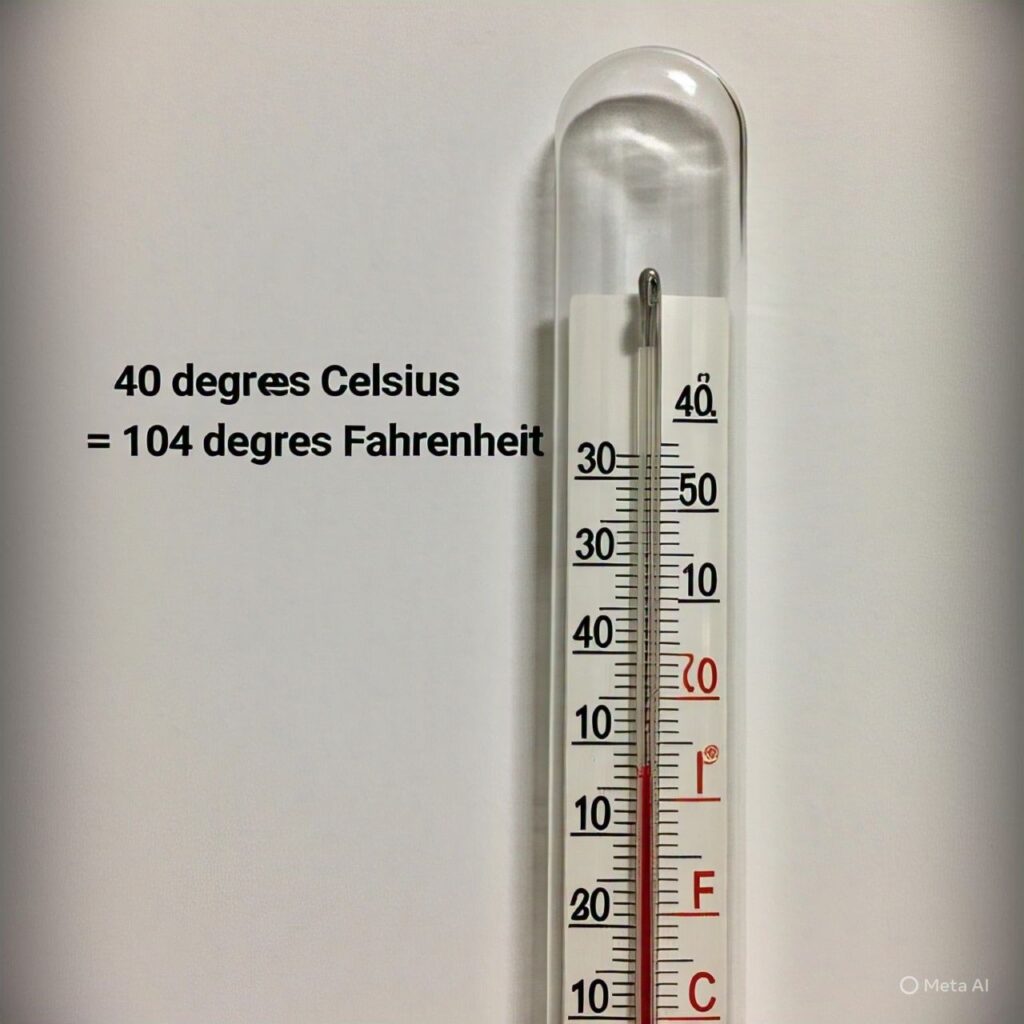
When you’re traveling, cooking, or studying science, converting temperatures between Celsius and Fahrenheit is essential. One common conversion is 40 degrees C to F, which often puzzles those unfamiliar with the temperature conversion formulas. In this article, we’ll explore what 40 degrees Celsius in Fahrenheit means, how to convert between the two scales, where this temperature might be encountered, and answer some frequently asked questions.
What Does 40 Degrees C to F Equal?
To convert 40 degrees Celsius to Fahrenheit, you use the standard temperature conversion formula:
F = (C × 9/5) + 32
Applying this formula:
F = (40 × 9/5) + 32
F = (72) + 32
F = 104
So, 40 degrees C to F equals 104 degrees Fahrenheit.
This temperature is considered very hot, especially when referring to environmental or body temperatures. It’s critical to understand what such temperatures mean in context.
The Celsius and Fahrenheit Scales: A Quick Overview
Before diving deeper, it’s important to understand the difference between Celsius and Fahrenheit.
The Celsius Scale (°C)
- Widely used globally, especially in scientific contexts and by most countries.
- Freezing point of water: 0°C
- Boiling point of water: 100°C
The Fahrenheit Scale (°F)
- Used primarily in the United States and a few other countries.
- Freezing point of water: 32°F
- Boiling point of water: 212°F
Both scales measure temperature, but they originate from different scientific and cultural backgrounds, leading to different numerical readings for the same thermal conditions.
Why Convert 40 Degrees C to F?
Understanding what 40 degrees Celsius in Fahrenheit means can be useful in several scenarios:
1. Travel and Weather
If you’re traveling from the U.S. to a country using Celsius, or vice versa, knowing how hot 40°C is in Fahrenheit is vital. At 104°F, you can expect sweltering heat, possibly heatwave conditions.
2. Health Monitoring
A human body temperature of 40°C is a medical emergency. It translates to 104°F, indicating high fever or heatstroke.
3. Science and Engineering
Many scientific studies use the Celsius scale, so converting to Fahrenheit is necessary for understanding or communicating findings in places where Fahrenheit is standard.
Practical Conversion Examples
Let’s take a few scenarios to understand what 40 degrees C to F really means in practice.
Outdoor Temperature
If a weather report says the temperature is 40°C, it means:
- 104°F
- It’s extremely hot.
- You should stay hydrated, wear sunscreen, and avoid prolonged sun exposure.
Cooking and Baking
In cooking, especially when using international recipes, oven temperatures might be listed in Celsius:
- 40°C = 104°F is not typically used for baking but might be used for:
- Proofing bread dough
- Keeping food warm
Fever Check
A fever of 40°C is 104°F:
- This indicates high-grade fever.
- It requires immediate medical attention, particularly in children or vulnerable adults.
How to Convert Celsius to Fahrenheit (And Vice Versa)
While calculators and apps can easily handle conversions, understanding how to do it manually is helpful.
Formula for Celsius to Fahrenheit
F = (C × 9/5) + 32
So:
- 0°C = 32°F
- 20°C = 68°F
- 40°C = 104°F
Formula for Fahrenheit to Celsius
C = (F – 32) × 5/9
So:
- 32°F = 0°C
- 68°F = 20°C
- 104°F = 40°C
Understanding this relationship is key when interpreting temperatures in either scale.
Chart: Celsius to Fahrenheit Quick Reference
Here’s a quick reference for other common Celsius temperatures converted to Fahrenheit:
| Celsius (°C) | Fahrenheit (°F) |
|---|---|
| 0 | 32 |
| 10 | 50 |
| 20 | 68 |
| 30 | 86 |
| 40 | 104 |
| 50 | 122 |
| 100 | 212 |
This chart shows just how steep the Fahrenheit readings can get with increasing Celsius temperatures.
Is 40 Degrees Celsius Dangerous?
Yes, in most contexts, 40°C or 104°F can be dangerous.
Health Risks
- Body temperature of 40°C = Medical emergency.
- Risk of heatstroke, especially in infants, elderly, and those with chronic illnesses.
- Symptoms include confusion, dizziness, rapid heartbeat, and lack of sweating.
Environmental Exposure
- High outdoor temperatures of 40°C (104°F) can cause:
- Dehydration
- Heat exhaustion
- Sunburns
Precautionary measures include:
- Wearing light clothing
- Avoiding the sun during peak hours
- Staying indoors when possible
Fun Facts About Temperature
- The hottest temperature ever recorded on Earth: Around 56.7°C (134°F) in Furnace Creek, California.
- Average human body temperature: 37°C or 98.6°F.
- Water boils at: 100°C or 212°F at sea level.
- Absolute zero (coldest theoretical temperature): −273.15°C or −459.67°F.
Understanding how 40 degrees C to F fits into this spectrum highlights how extreme it really is.
Tips for Dealing with 40°C (104°F) Heat
If you’re in a location where the temperature hits 40 degrees C, here’s how to stay safe:
1. Stay Hydrated
Drink water frequently, even if you don’t feel thirsty.
2. Dress Smart
Wear light-colored, breathable clothing.
3. Limit Outdoor Activity
Stay indoors during peak heat hours (10 a.m. – 4 p.m.).
4. Use Cooling Devices
Fans, air conditioning, or even damp cloths can help lower your body temperature.
5. Monitor for Heat Illness
Be aware of the signs of heat exhaustion and heatstroke.
Frequently Asked Questions (FAQs)
Q1: What is 40 degrees C to F?
A: 40 degrees Celsius equals 104 degrees Fahrenheit.
Q2: Is 40°C hot or cold?
A: 40°C (104°F) is very hot. It is often associated with heatwaves and can pose health risks.
Q3: Can a human survive a body temperature of 40°C?
A: A body temperature of 40°C is considered a medical emergency and requires urgent treatment. Prolonged exposure can lead to heatstroke or organ failure.
Q4: How do I quickly convert Celsius to Fahrenheit?
A: Use the formula:
F = (C × 9/5) + 32
Or estimate by doubling the Celsius and adding 30 (less accurate but faster).
Q5: Why do some countries use Celsius and others Fahrenheit?
A: Celsius is part of the metric system, adopted by most countries. Fahrenheit is mainly used in the United States, partly due to historical standards and familiarity.
Q6: What should I do during a 40°C (104°F) heatwave?
A: Stay cool indoors, drink water frequently, and avoid strenuous activity. Protect pets and check on vulnerable individuals.
Q7: What does 40°C feel like?
A: It feels oppressively hot. Sweat evaporates quickly, leading to rapid dehydration. Sun exposure can cause burns and exhaustion within minutes.
Q8: Is 40 degrees C to F the highest temperature on Earth?
A: No. 40°C is very hot, but temperatures in some desert regions have reached over 50°C (122°F).
Q9: Is 40 degrees Fahrenheit cold?
A: Yes. 40°F is approximately 4.4°C and feels chilly. Don’t confuse it with 40°C, which is hot.
Q10: Can I cook at 40 degrees Celsius?
A: Not typically. 40°C is too low for most cooking methods but may be used for fermentation or dough proofing.
Summary: Why 40 Degrees C to F Matters
Understanding 40 degrees C to F is more than just a simple math problem—it’s about knowing what temperatures mean in real life. Whether you’re checking the weather, monitoring a fever, or interpreting scientific data, the ability to convert and contextualize temperature is invaluable.
At 40 degrees Celsius (104°F):
- You’re dealing with extreme heat.
- Proper precautions are essential.
- It’s a benchmark for serious medical and environmental conditions.
So the next time you hear “40 degrees C to F,” you’ll know it’s 104°F—a number that calls for both respect and readiness.







